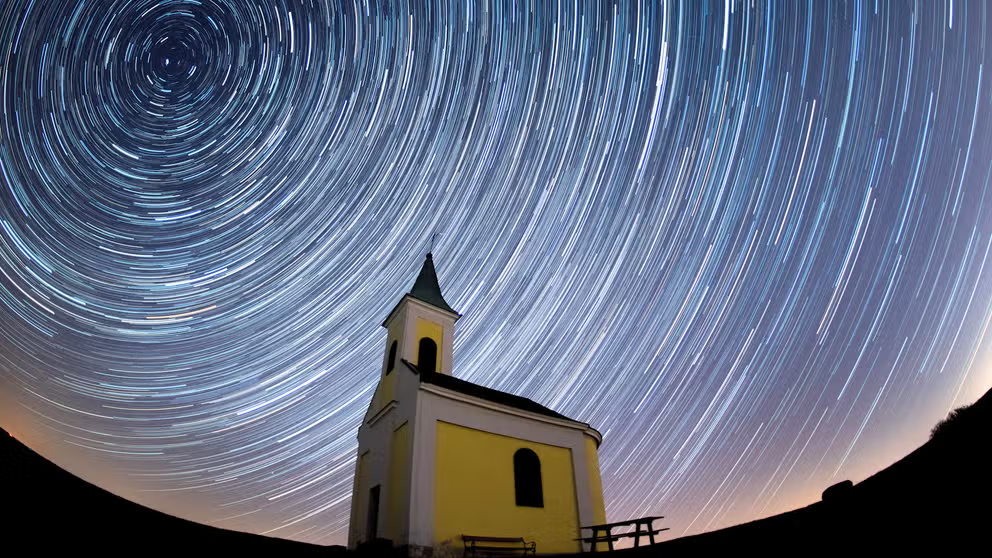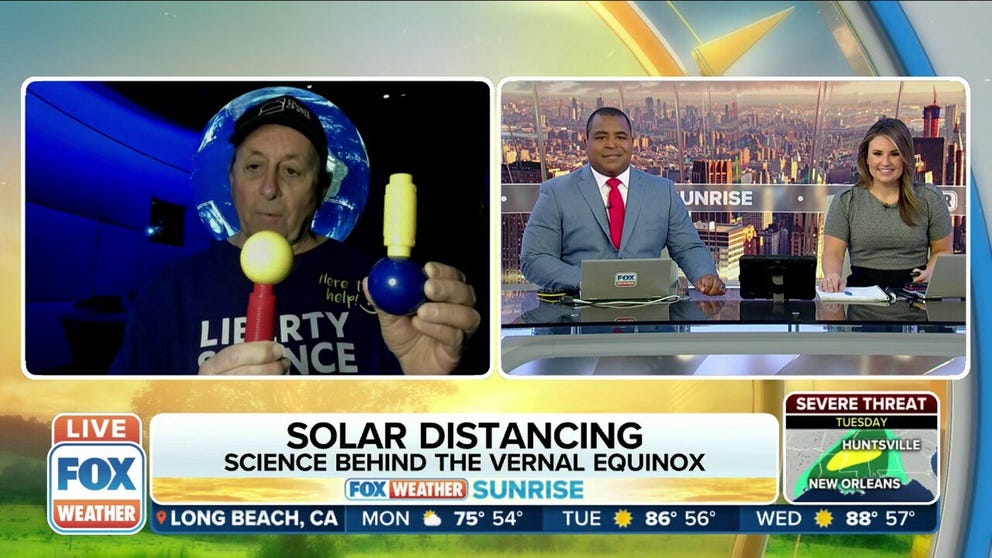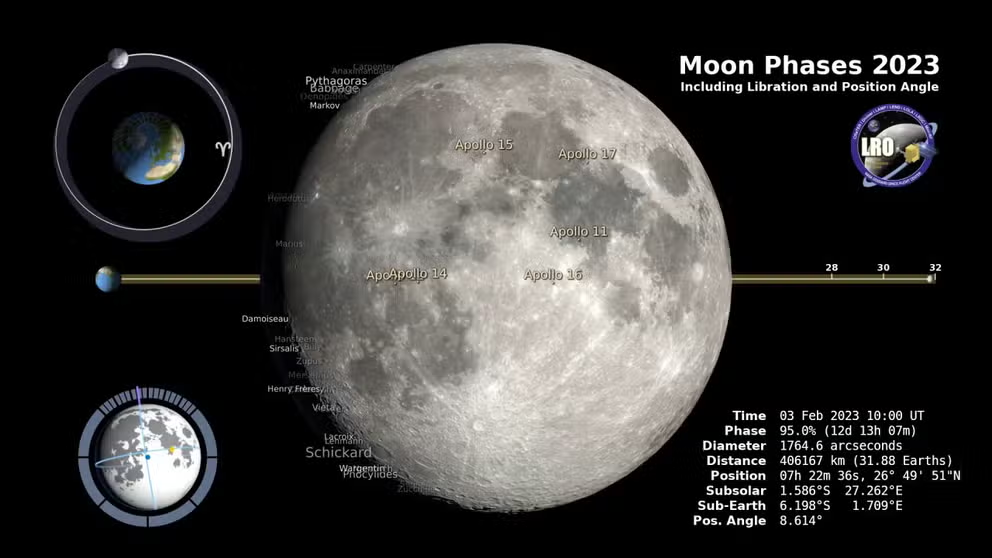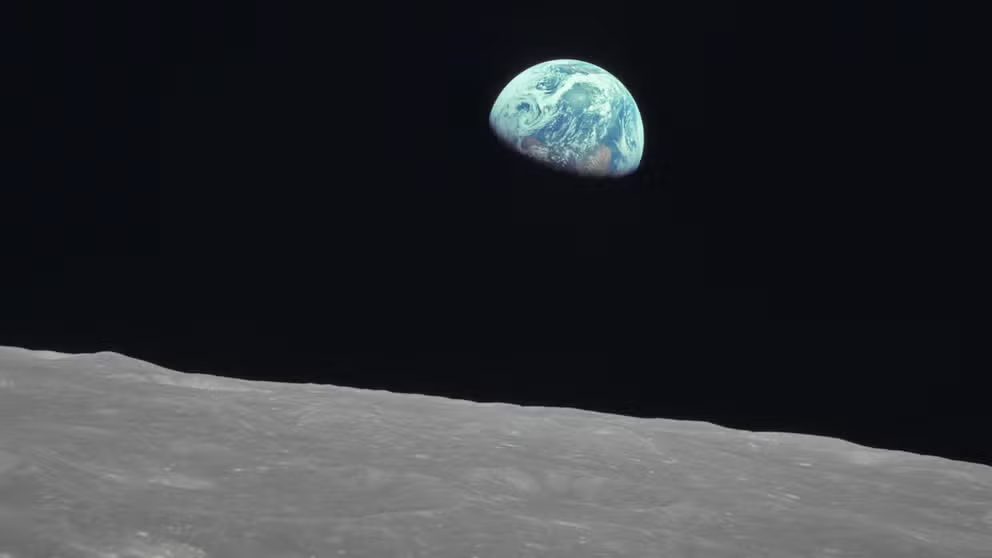Watch out for these astronomical events in 2023
The year will feature 13 full moons, plenty of meteor showers and four eclipses.
Meteor showers explained: what to know and how to watch
We call them shooting stars, but it's actually meteors that create dazzling streaks of light across our night sky.
Our solar system is thought to be made of eight planets and has more than 4,000 known comets, each with the potential of lighting up the night sky.
Due to advancements in astronomy, many of the events are tracked, and it can be determined well ahead of time when the celestial bodies may be visible with or without the help of either binoculars or a telescope.
In 2023, the sky will be illuminated by 13 full moons, plenty of meteor showers and four eclipses.
Here's a look at the best astronomical events you won't want to miss this year.
7 TIPS ON HOW TO SHOOT THE MOON WITH A CAMERA
January
3rd-4th: Quadrantid meteor shower peak
The annual meteor shower that began in late December peaks in early-January every year.
Some consider the meteor shower the best of the year, but the peak only lasts a few hours each night.
NASA said that during the height of activity, dozens of meteors can be seen every hour if the skies are clear.
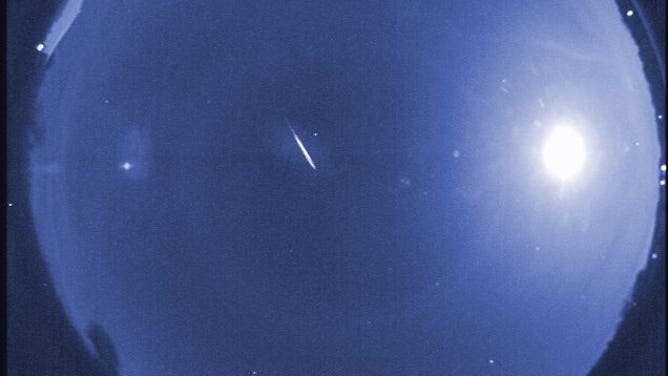
False-color image of a Quadrantid meteor shower, captured by a NASA in 2010.
(NASA)
6th: Full wolf moon
The first full moon of the year will rise in the east and peak at 6:08 p.m. EST.
The Farmer's Almanac believes the nickname originates from the time period when Native Americans noticed wolves howling in hunger at the moon.
If skies are cloudy, or you miss seeing the moon in all its glory on Jan. 6, it will appear nearly as bright on the night of Jan. 7.
February
1st: Comet C/2022 E3 (ZTF) visible
A comet that was only discovered in March 2022 by a team at the Zwicky Transient Facility could be bright enough in the night sky to be visible without the use of a telescope.
Comet C/2022 E3 will make its closest approach to the sun in January and safely pass Earth by a distance of more than 27 million miles.
Due to its orbit, the frozen celestial body will be visible in the northern sky for an extended time in North America.
5th: Full snow moon
The year's second full moon will peak in brightness during the first weekend of February.
The snow moon will reach full status about 1:29 p.m. EST, but because North America will be in the middle of the afternoon, the continent will have to wait until after sunset to see the moon in all its glory if the skies are clear.
The moon got its nickname because February is usually a chilly month with plenty of snow on the ground in the northern latitudes.
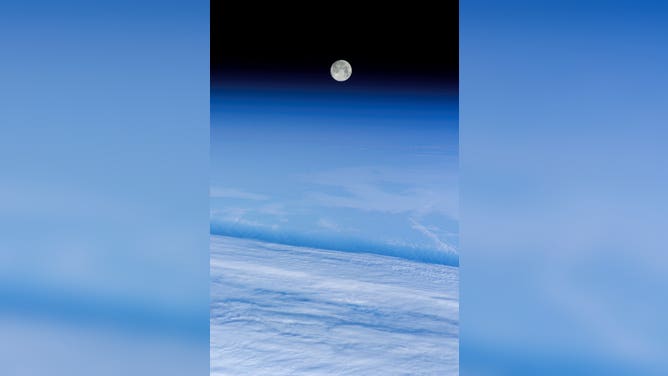
Snow moon over Earth taken from the International Space Station 02/12/06.
(NASA)
8th: Alpha Centaurids meteor shower peak
The α-Centaurid meteor shower is visible from late January through February, with a peak just before Valentine's Day.
This meteor shower is typically best viewed from the Southern Hemisphere, but glimpses can occur north of the equator.
The American Meteor Society said it is not unusual to see fireballs mixed in the meteor shower as February marks the start of the season, which lasts through most of the spring.
22nd: Moon, Jupiter and Venus put on a show
As the moon starts gaining visibility during its waxing crescent stage, the lunar body will pass in front of a bright Jupiter.
Even though the two features will appear close in the western sky, they'll actually be hundreds of millions of miles away.
In addition to the moon and the giant gas planet being visible from Earth, Venus will be at one of its brightest stages.
With the help of a telescope, all should be visible after sunset.
FIRST COLOR IMAGES FROM NASA'S JAMES WEBB SPACE TELESCOPE REVEAL BRILLIANT NEBULA, GALAXY CLUSTERS
March
7th: Full worm moon
When the Earth is located between the sun and the moon, the year's third full moon will occur.
Peak illumination is set to happen at 7:40 a.m. EST, meaning those in North America will either have to see the moon in all its glory the night before or after it reaches the full moon stage.
The Farmers' Almanac said the moon got its nickname because the ground in the northern latitudes begins to soften during the month allowing earthworms to appear.
The moon takes about 29.5 days to complete a full cycle, and the next full moon will be in early April.

The moon takes about 29.5 days to complete a full cycle.
(NASA)
20th: Spring equinox
Astronomical spring will begin on Monday, March 20th, at 5:24 p.m. EDT.
On this occasion, the sun's rays will be directly over the equator, meaning communities north and south of the equator have nearly equal amounts of day and night.
The occasion, also known as the vernal equinox, means the continuation of earlier sunrises and later sunsets in the Northern Hemisphere through June's solstice.
The science behind the vernal equinox
Michael Shanahan, Planetarium Director at Liberty Science Center, explains the science behind the vernal equinox.
April
6th: Full pink moon
The first full moon of spring usually coincides with the sprouting of the season's first flowers.
Unlike the three previous that happened outside prime viewing hours in North America, the full pink moon will reach its peak illumination at 12:34 a.m. EDT.
To the dismay of some, the moon will not appear pink even though the nickname may suggest it. Instead, the moon could appear yellow or orange due to the angle of the light and its interaction with Earth's atmosphere.
When the moon appears lower in the sky, light rays have farther to travel, which silences some wavelengths and creates a yellow or even orange hue.
20th: Hybrid solar eclipse
This rare event will only be visible in parts of Australia, Indonesia and Oceania when the moon moves between the sun and the Earth.
Most areas impacted by this event will see a partial eclipse, with only limited areas under the moon's full shadow.
The partial eclipse is known as the "ring of fire" because the moon does not cover the entire sun and leaves a sliver of the sun visible.
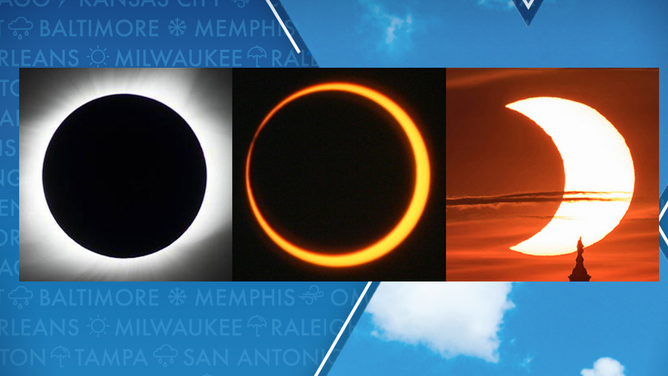
Photos from left to right show a total solar eclipse, annular solar eclipse, and partial solar eclipse.
(NASA/Bill Dunford/Bill Ingalls / NASA)
22nd-23rd: Lyrids meteor shower peak
Space debris from comet C/1861 G1 Thatcherm will be visible during the night of April 22nd and the morning of April 23rd.
NASA said the comet was originally discovered by astronomer A.E. Thatcher in 1861 and since then has not completed an entire orbit around the sun.
The comet is estimated to take around 415 years to complete a full orbit.
Due to the moon's stage, skies could be dark enough to see up to 20 meteors per hour.
PIECE OF SPACE SHUTTLE CHALLENGER DISCOVERED OFF FLORIDA COAST 37 YEARS LATER
May
4th-5th: Eta Aquarids meteor shower peak
The comet Halley usually produces one of the better meteor showers of the year to check out.
NASA said the Eta Aquarids usually leads to about 60 meteors per hour, but due to the event's closeness to the full moon, much of the debris will not be visible.
The best viewing will be if the skies are clear and you are well away from any light pollution.
The comet is thought to be at least 16,000 years old and also leads to October's Orionids meteor shower.
NASA said that the peak for the Eta Aquarids meteor shower will be from May 4-5.

An Eta Aquarid meteor streaks over north Georgia on April 29, 2012.
(NASA)
5th: Full flower moon
The full moon will be on the opposite side of the world from North America when it reaches peak illumination, so the best time to view the lunar body will be during the evening.
The Farmers' Almanac said the moon gained its nickname through observations by Native Americans who noted flowers were in abundance during the late spring.
Other names for the lunar body include the corn-planting moon and the milk moon.
This full moon event will also include a penumbral lunar eclipse, but it will not be visible in North America.
Areas mainly in the Eastern Hemisphere will temporarily see Earth's shadow cover a portion of the moon.
The next penumbral lunar eclipse visible in North America will be in March 2024.
29th: Great view of Mercury
During the early morning hours of May 29, the first planet of our solar system will appear bright due to its distance from the sun.
The event is called the planet's greatest western elongation and will be one of three times Mercury reaches this stage.
Due to the moon, viewing of the first event in January was considered poor, and if you miss May's event, the final one for the year will be in September.
Only the inferior planets, or those closer to the sun than Earth, reach a stage of greatest western elongation or greatest eastern elongation.
June
3rd: Full strawberry moon
The first full moon of meteorological summer will reach its peak at 11:42 p.m. EDT, meaning if skies are clear, the viewing will be great.
June is the peak season for the summer fruit and is the reason behind its nickname of the full strawberry moon. Strawberries are typically planted after the last frost in the spring and are ready to be plucked during summer.
The strawberry moon is one of two full moons that are nicknamed after agriculture.
Video: Moon phases in 2023
The moon will be full 13 times in 2023 thanks to its orbit.
July
3rd: Full thunder moon
The moon nicknamed for the antlers on male deer will peak during the morning hours in North America.
The Farmer's Almanac said this full moon is typically also called the full thunder moon or the hay moon.
In addition to being full, the moon will also be what is known as a supermoon.
Supermoons occur a few times a year when the lunar body reaches what is known as perigee. Perigee is the closest point to Earth while in orbit.
Because of its close approach, the full thunder moon will appear brighter and larger than an average moon.
28th-29th: Delta Aquarids meteor shower peak
If you see a meteor anytime from mid-July through the middle of August, it is likely part of the Delta Aquarids.
The meteor shower comes from the comets Marsden and Kracht.
Due to the approaching full moon, viewing could be difficult, but astronomers said upwards of 20 meteors per hour can fill the sky.
August
1st: Full sturgeon moon
The eighth full moon of the year will also be the second supermoon of 2023.
The supermoon is scheduled to reach its peak at 2:31 p.m. EDT, but because of the timing, North America will have to wait for several hours until the sun sets and the moon rises to see it in all its glory.
It is widely accepted that the moon is known as the full sturgeon moon because fish in the Great Lakes and other regions of North America are more easily caught before the summer winds down.
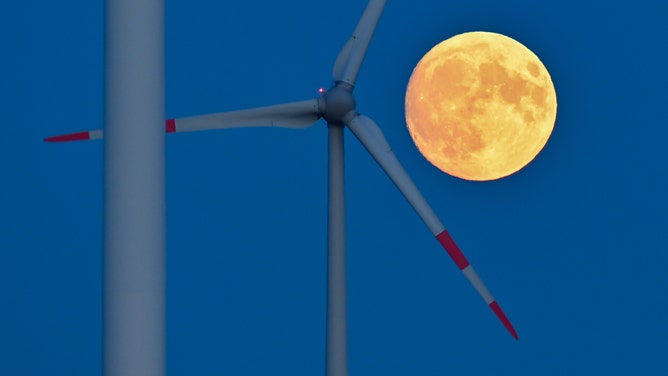
12 July 2022, Brandenburg, Sieversdorf: The moon, which is about 95 percent visible and waxing, glows yellowish in the sky next to a wind turbine shortly after sunset. On the night of July 13, 2022, a super full moon can be seen in the sky with good visibility. At moonrise around 10 p.m., the Earth's satellite will be 357,517 kilometers from Earth. Despite this distance, it will be the largest supermoon of the year.
(Patrick Pleul/dpa / Getty Images)
12th-13th: Perseids meteor shower
The comet Swift-Tuttle is capable of producing up to 100 meteors per hour during the Perseids meteor shower, making it one of the best meteor showers of the year.
The Perseids kick off in mid-July and lasts through late August, with its peak during the night of Aug. 12 and early morning of Aug. 13.
In North America, viewing can start as early as 10 p.m. and last through the pre-dawn hours.
NASA said fireballs, which are bright and large meteors, tend to be bountiful during the Perseids.
27th: Great viewing of Saturn
The second-largest planet in the solar system will be bright in the night sky as it makes its closest approach to Earth at a mere 830 million miles away.
The giant ringed planet will be centered in the constellation Aquarius and will be in opposition.
This means Earth will be between the sun and Saturn.
Astronomers said that with the help of a telescope, some of the planet's 83 moons could also be visible.
WEATHER WATCHERS NEEDED TO LOCATE CLOUDS ON MARS
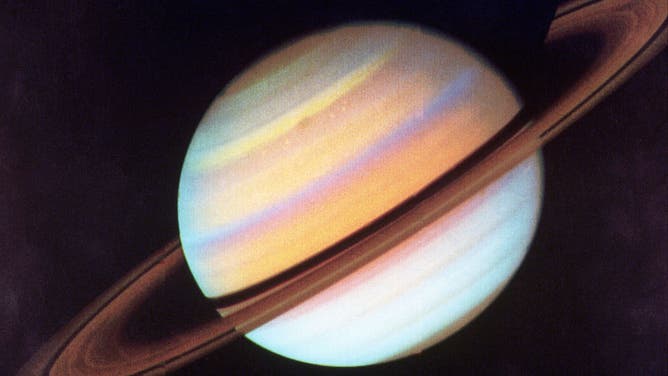
Image of Saturn taken by the Voyager Spacecraft at a distance of 21.1 million miles. Color enhanced by NASA
(Getty Images)
30th: Full blue moon
August will hold the unique distinction of having two full moons and the second event will be known as the full blue moon.
Seeing two full moons in a calendar month happens once every two or three years, NASA says.
The moon will not appear blue but could be rather large because the lunar body will be a supermoon.
September
19th: Great views of Neptune
The eighth planet's night to light up the sky happens in mid-September when the planet aligns with the sun and Earth.
Astronomers said you'll likely need a telescope to see the planet that will be some 3 billion miles away.
If the skies are clear, the best viewing is between midnight and sunrise.
22nd: Great views of Mercury
A few days after Neptune reaches opposition, the smallest planet in our solar system will be visible.
Mercury will be as far west as it can get from the sun, causing it to be visible from Earth.
Due to its greatest western elongation, observers will be able to view the planet before sunrise.
23rd: Fall equinox
The Northern Hemisphere will enter astronomical fall when the sun's rays will be directly over the equator.
This astronomical event signifies there are nearly equal amounts of day and night throughout the world.
The autumnal equinox is known as the vernal equinox for areas south of the equator and signifies the arrival of spring for residents in South America, Australia, much of Africa and southern Asia.
Autumn's equinox in the Northern Hemisphere will be at 2:50 a.m. EDT.
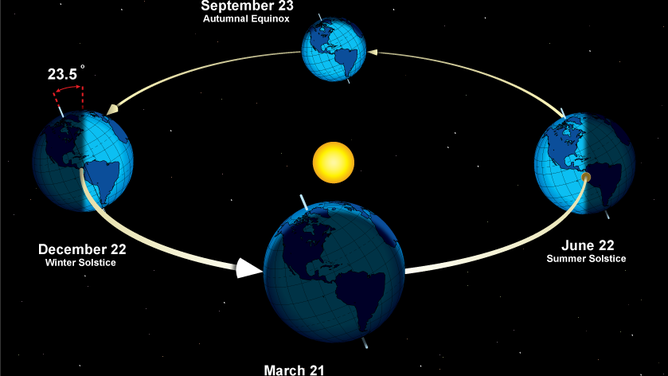
The fall equinox this year is on September 23.
(NOAA)
29th: Full harvest moon
Less than a week into astronomical fall, September's full moon will light up the evening sky. The peak illumination will happen at 5:57 p.m. EDT., so much of the U.S. will have to wait until after sunset to see the moon in all its glory.
The full moon closest in time to the fall equinox earns the nickname of the harvest moon, which can occur as late as in October.
According to The Farmers' Almanac, the nickname revolves around the lunar body providing plenty of light for Native Americans and farmers to work on their harvests before the season's chilly air arrives.
UFO SIGHTINGS TO BE STUDIED BY FORMER ASTRONAUT, HANDPICKED NASA GROUP
October
14th: Partial solar eclipse
The annular eclipse will pass through much of the western U.S. and begin over the Oregon coast at 9:13 a.m. local time and exit the country over Texas.
Unlike a total solar eclipse where the sight of the sun is completely blocked by the moon, a thin sliver of the giant star will be visible this go around, creating what some describe as a "ring of fire" look.
The American Astronomical Society said communities underneath the path may see the eclipse for up to five minutes as the moon passes between the Earth and the sun.
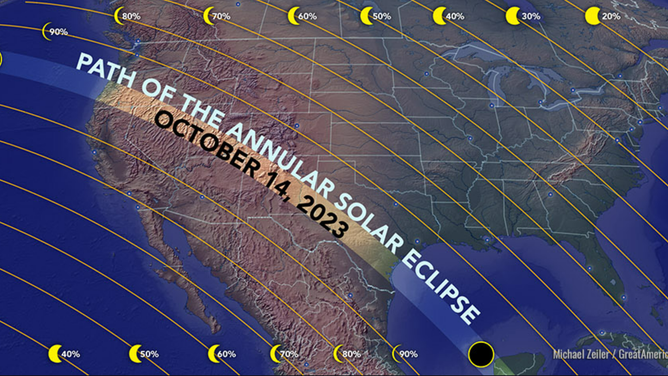
October eclipse map
(Michael Zeiler/GreatAmericanEclipse.com / FOX Weather)
Experts suggest that you should don safety glasses or use another form of eye protection if you want to view the event. It is never safe to look directly at a solar eclipse.
An event dubbed the Great American Eclipse will travel across much of the U.S. in 2024, and unlike October's event, it will be a total eclipse.
21st-22nd: Orionid meteor shower peak
The Orionids meteor shower peaks annually during mid-October and is visible across the Northern Hemisphere after midnight.
NASA said the space particles originate from comet 1P/Halley.
During past events, around 15 meteors have been spotted per hour under the skies of the waning crescent.
28th: Partial lunar eclipse
The moon will partly pass through Earth's shadow, making it appear as if a chunk of the lunar body is missing.
Due to the timing of the event, nearly all of North America will miss out on the partial eclipse, but Asia, Africa and Europe could have prime viewing.
If skies are clear, parts of the Northeast U.S. could see a sliver of the eclipse at moonrise during the early evening.
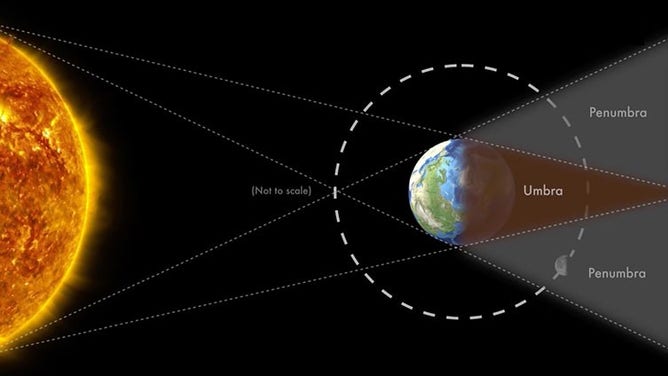
Example of a lunar eclipse
(NASA)
28th- Full hunter's moon
The full moon will peak during the afternoon of Oct. 28, meaning the best time to view the full hunter's moon will be during the evening hours in North America.
The official peak will happen at 4:24 p.m. EDT Saturday but will be bright through the entire weekend.
According to the Farmers' Almanac, October was the time of the year when Native Americans began stocking up on food for the winter months.
IMPROVED SPACE WEATHER FORECASTS NEEDED TO AVOID DESTRUCTION OF SATELLITES
November
3rd: Great view of Jupiter
The largest planet in the solar system will appear bright during the morning hours.
Jupiter reaches opposition when the sun, Earth and the giant gaseous planet are aligned.
The planet and its 80 moons will be around 370 million miles from Earth.

HOBOKEN, NJ - SEPTEMBER 26: Jupiter rises above the Empire State Building in New York City in opposition to the sun as it makes its closest approach to the Earth since 1963 at a distance of 367 million miles on September 26, 2022, as seen from Hoboken, New Jersey.
(Gary Hershorn/Getty Images / Getty Images)
18th: Leonid meteor shower peak
Most of the month, the Leonid meteor shower will be visible but will peak mid to late November
NASA said the rate of countability is typically low at only about 15 meteors per hour, but they can be bright.
The Leonids are best viewed around midnight.
Astronomers said about every 33 years, Earth travels through a Leonid storm with hundreds or even thousands of meteors, but the next large-scale event won't likely happen until 2025.
27th: Beaver full moon
Just four days after Thanksgiving, the full beaver moon will light the night sky. Peak illumination will occur at 4:16 a.m. EST.
According to the Farmer's Almanac, there are varying thoughts about how the moon got its nickname. Some believe it originated because of traps put out by Native Americans to capture beavers. Others believe it comes from beavers building their winter dams before the waterways freeze.
WHEN CAN YOU EXPECT THE FIRST SNOW OF SEASON?
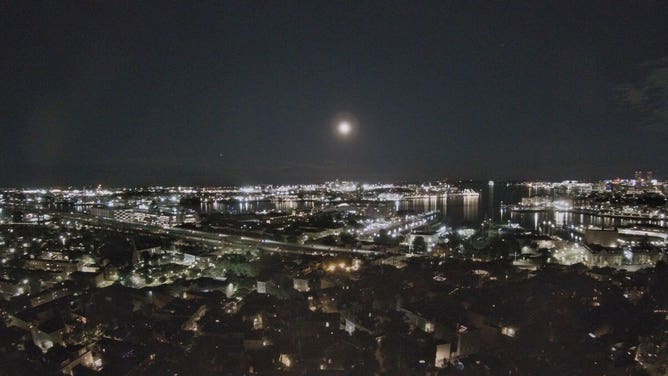
Full moon over the Boston Harbor on Nov. 8, 2022
(NASA)
December
14th: Geminid meteor shower peak
This meteor shower peaks in mid-December and space experts said it has been gradually growing since its first appearance in the 1800s.
If optimal sky conditions exist, 120 Geminid meteors can be spotted every hour.
Thanks to the moon being in a new phase, interference from the lunar body is minimal.
The light show typically starts after 9 p.m. and peaks shortly after.
21st: Winter solstice 2023
Earth's North Pole will reach the greatest tilt away from the sun on the winter solstice.
The Earth is tilted at approximately 23.5 degrees. Because of this tilt, most direct sunlight is aimed at the Southern Hemisphere.
After around Dec. 21, daylight starts to increase across the Northern Hemisphere and will do so through the summer solstice in 2024.
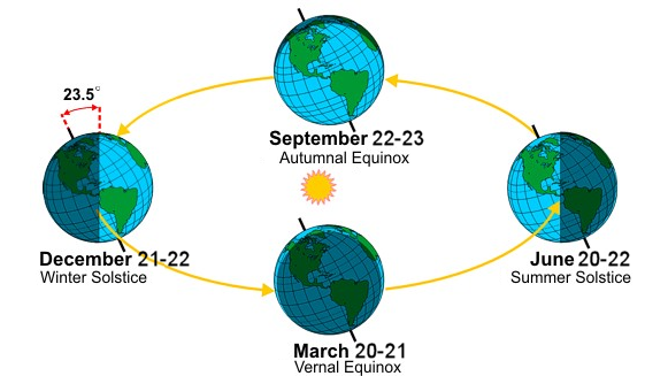
The Earth's orbit around the sun gives our planet its four seasons.
(NOAA)
26th: Cold full moon
The final astronomical sight to catch in the sky for the year will be the cold full moon.
If the skies are clear, the lunar body will reach full illumination at 7:33 p.m. EST.
The moon's nickname coincides with cold weather and winter's arrival in the Northern Hemisphere.
The first full moon of 2024 won't grace the sky until Jan. 25, 2024.
Joy to the Moon: A look back at Apollo 8's historic Christmas Eve broadcast
On Christmas Eve in 1968, Apollo 8’s astronauts captivated the world with a live broadcast from lunar orbit.
